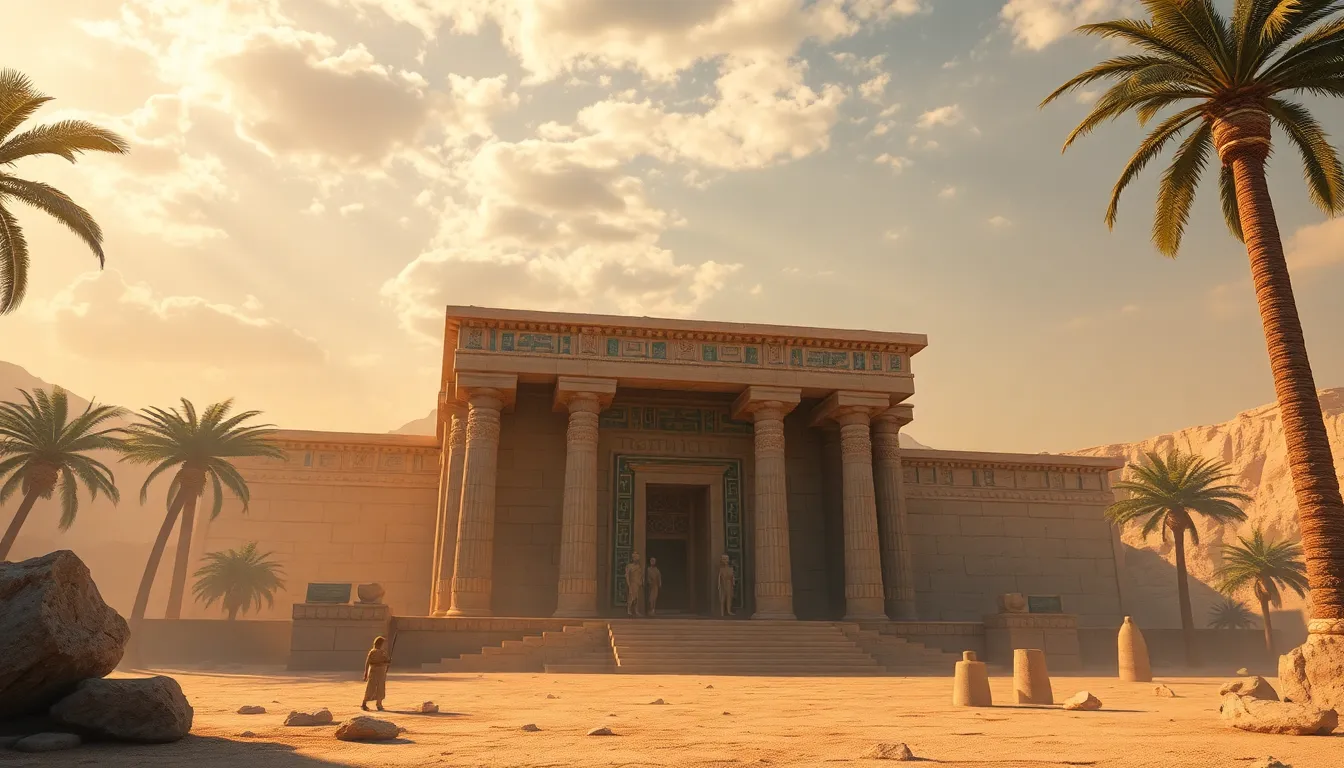The Temple of Tefnut: The Goddess of Moisture
I. Introduction
Tefnut, the ancient Egyptian goddess of moisture, plays a crucial role in the pantheon of Egyptian mythology. As the embodiment of moisture, she was essential for agriculture and sustenance in a land predominantly characterized by arid conditions. This article aims to explore the historical context, architectural features, rituals, and theological significance of the Temple of Tefnut, as well as its impact on ancient Egyptian society and beyond.
II. Historical Context of Tefnut
Tefnut’s origins are deeply rooted in the Heliopolitan creation myth, where she and her brother Shu, the god of air, emerged from the primordial waters of Nun. Together, they separated the sky from the earth, establishing order in the universe. Tefnut’s relationship with Shu is particularly significant, as they together symbolize the balance between moisture and air, which is vital for life.
The significance of moisture in agricultural practices cannot be overstated. In ancient Egypt, the annual flooding of the Nile River, which brought nutrient-rich silt to the land, was viewed as a blessing from the gods, including Tefnut. Without moisture, crops would fail, leading to famine and hardship.
III. Architectural Features of the Temple of Tefnut
The Temple of Tefnut, located in the ancient city of Heliopolis, was a magnificent structure reflecting the architectural prowess of ancient Egyptians. The temple was designed to honor Tefnut and facilitate her worship.
- Location: The temple was situated in a prominent area, often associated with the sun god Ra, enhancing its spiritual significance.
- Layout: The temple complex typically included a large courtyard, sanctuaries, and offering chapels, designed to accommodate worshippers and priests.
Key architectural elements of the temple included:
- Pillars: Decorated with intricate carvings depicting Tefnut and her attributes.
- Obelisks: Tall stone pillars that often symbolized sunlight and were frequently associated with the gods.
Artistic representations and inscriptions related to Tefnut adorned the walls, showcasing her importance in the daily lives of the Egyptians and their reliance on her for moisture and fertility.
IV. Rituals and Worship Practices
Worship at the Temple of Tefnut was characterized by various rituals aimed at honoring the goddess and ensuring her favor. Common rituals included:
- Offerings: Farmers would bring offerings of grain and flowers to the temple, symbolizing gratitude for the moisture that sustains life.
- Prayers: Devotees would recite prayers requesting Tefnut’s blessings for rain and crop fertility.
The role of priests and priestesses was vital in the temple’s operations. They performed daily rituals, cared for the temple’s offerings, and communicated the needs of the people to Tefnut. Festivals dedicated to Tefnut, such as the annual flooding of the Nile, were celebrated with great fervor, featuring music, dance, and communal feasts.
V. Theological Significance of Tefnut
Tefnut’s attributes as the goddess of moisture place her in a unique position within the Egyptian pantheon. She is often depicted as a lioness, symbolizing both her nurturing and fierce aspects. This duality of moisture reflects its connection to life and chaos, as rain can both nourish and flood.
In comparison with other moisture-related deities in different cultures, Tefnut shares similarities with figures like the Mesopotamian goddess Ninhursag and the rain god Tlaloc from Aztec mythology. Each goddess embodies the essential life-giving force of moisture, highlighting its universal importance across civilizations.
VI. Archaeological Discoveries and Findings
Major excavations related to the Temple of Tefnut have uncovered valuable insights into ancient Egyptian worship practices. Archaeologists have discovered:
- Artifacts: Pottery, tools, and religious items that highlight the daily life and rituals of those who worshipped Tefnut.
- Inscriptions: Texts that provide context for the temple’s significance, detailing offerings and prayers dedicated to Tefnut.
The current state of the temple site is a focus of preservation efforts, as scholars aim to protect and study this vital piece of Egyptian heritage. Ongoing research continues to shed light on the cultural and religious practices surrounding Tefnut’s worship.
VII. Cultural Impact and Legacy
Tefnut’s influence extended beyond religion into the agricultural practices of ancient Egypt. Farmers revered her as a protector of crops, attributing their success or failure to her favor. This connection to agriculture highlights her importance in sustaining the civilization.
In modern interpretations, Tefnut is represented in various forms of art, literature, and popular culture, reflecting a renewed interest in ancient mythology. The Temple of Tefnut remains a significant site in contemporary Egyptology, drawing scholars and tourists alike who seek to understand the complexities of ancient beliefs.
VIII. Conclusion
In conclusion, Tefnut’s significance in ancient Egyptian mythology is profound, as she embodies the essential element of moisture necessary for life. The Temple of Tefnut stands as a testament to her importance, both in ancient times and in modern scholarship. The enduring legacy of Tefnut and her temple underscores the critical role of moisture in sustaining civilizations and highlights the intricate relationship between humanity and the natural world.




